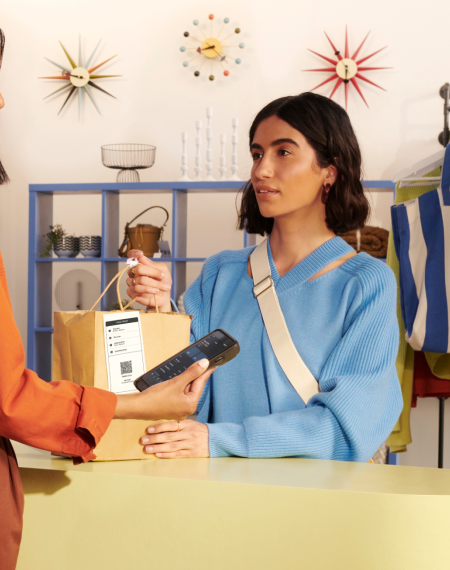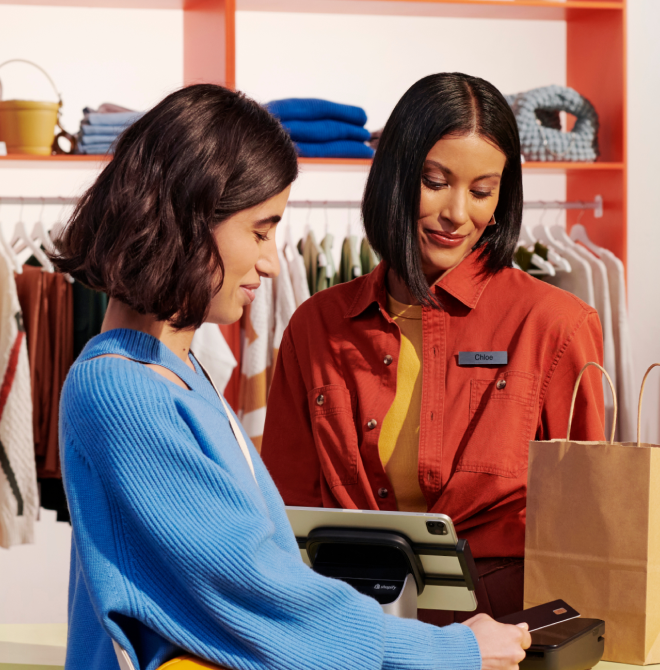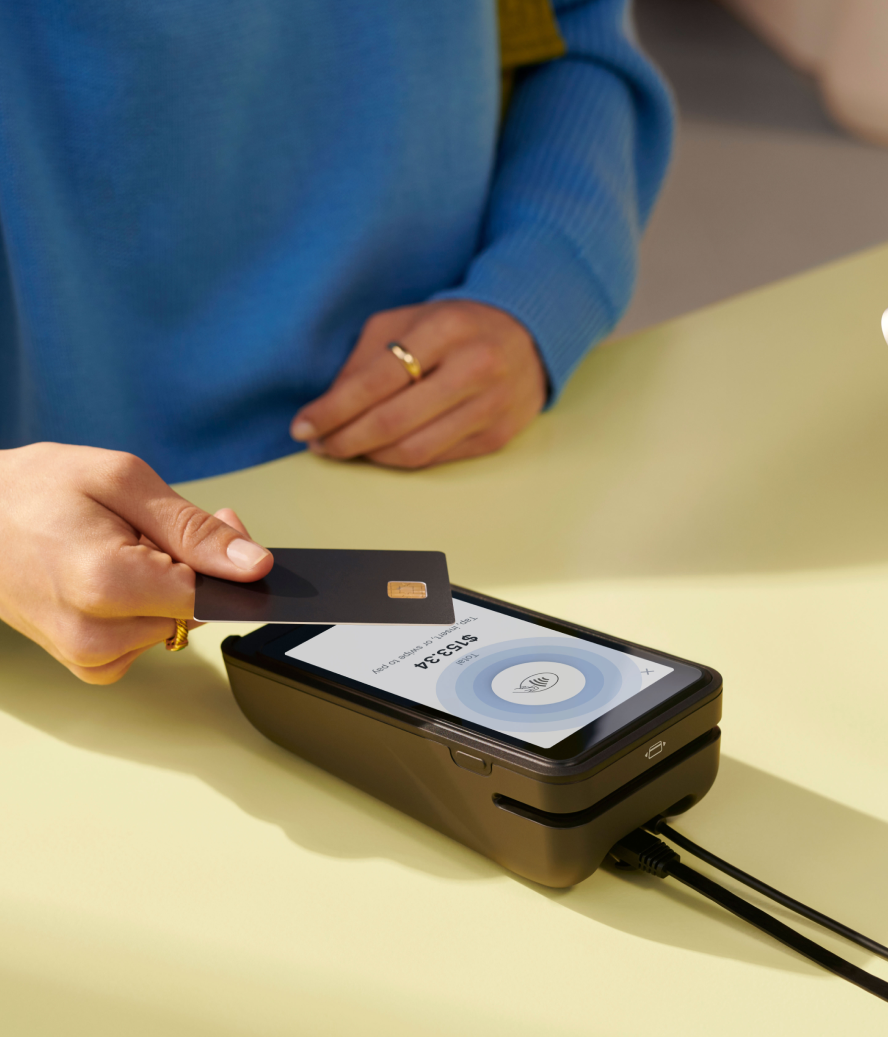A virtual fitting room is a type of technology that lets shoppers try on items virtually.
Shoppers can virtually try on clothing items or beauty products without physically touching them. The augmented reality (AR) or artificial intelligence (AI) technology places the item over live imaging of the customer, so they can check the size, style, and fit of a product they’re thinking of buying.
It’s predicted that the global virtual fitting room market will grow from $6.86 billion in 2025 to $24.30 billion by 2032. That’s a compound annual growth rate of 19.8%.
Interested in creating your own virtual dressing rooms? In this article, we’ll walk you through how virtual fitting room technology works (with examples), and the advantages for retailers.
What is a virtual fitting room?
A virtual fitting room allows shoppers to try on items without touching them. It works by overlaying an item on a live video feed of a customer via smartphones or mirrors. The shopper can see the size, style, and fit of an item before they buy it.
How virtual fitting room technology works
Most virtual fitting rooms work using augmented reality. In this case, a webcam scans a person’s body to create a 360-degree 3D model.
Other virtual fitting rooms are powered by artificial intelligence. Similar to augmented reality, AI uses algorithms and machine learning to take body measurements and create full-body 3D models of the shopper standing in front of the camera.
The 3D model created by AI or AR is combined with radio frequency identification (RFID). This is another technology that scans the products a shopper has taken to the virtual fitting room.
Virtual reality technology overlays the scanned products on the 3D model of the shopper. That way, they can see what they look like wearing an item—without needing to physically try it on. It's an easy way to build a try before you buy program virtually, one of several exciting innovations reshaping retail technology.
There are several different companies that offer this service and their pricing ranges with the level of features. Many require interested brands to reach out for a quote, but some costs range from $129 to $549 per month.
The benefits of virtual fitting rooms
There are multiple benefits that a virtual fitting room experience can provide for retailers.
Support online sales
Some 65% of visitors are more likely to place an order after interacting with a product in AR, fashion brand Rebecca Minkoff found.
Retailers can take advantage of this and install virtual mirrors in their brick-and-mortar stores. There’s no need to dedicate valuable retail space to changing rooms. Instead, that space can be used to showcase stock and create visual merchandising displays.
Convenience
Choosing the correct clothing size from the hanger, walking over to a physical changing room, and swapping their clothing is inconvenient. Automated retail technology, like virtual fitting rooms, eliminate all of that. Shoppers can walk over to a virtual mirror and quickly see what the clothing looks like on them—no changing needed.
Build connections with customers
Customer loyalty is a long-term goal for most retailers. To build long-term relationships with customers, you need to first build a connection with them through diverse shopping experiences.
Virtual fitting rooms play a role in that process. If you’re allowing shoppers to try items on virtually in the comfort of their own home or in the middle of a safe retail store, you’re solving a huge problem for them.
Overall, virtual fitting rooms make online shopping more fun. That’s a surefire way to get customers coming back.
Reduce return rates
High return rates plague fashion brands. It’s an administrative headache and cuts into profits (especially if you’re offering free returns).
Smart retail solutions like virtual fitting rooms solve that problem. Shoppers—regardless of whether they’re trying on in-store or online—get to see what the item looks like on their body … without needing to touch it. Data from AI-powered virtual fitting room app Fytted found that they’ve reduced returns by over 40%.
The limitations of virtual fitting rooms
Customers still can’t physically touch items
If you’re using a virtual fitting solution for your online store, there’s still a risk that people won’t buy the items they’re trying on.
Some 57% of consumers said they want to view and touch products before buying them online. While virtual fitting rooms help shoppers see what items will look like on their body, they’re unable to feel the fabric.
Distrust of virtual items looking the same
Ever bought something online that looks totally different from the item that arrived in the mail?
While virtual fitting room technology is advanced, some shoppers still don’t feel confident in its ability to portray items the way they look in real life. They fear that items overlaid on a human body may be altered and won’t look the same when they try it on for the first time.
The technology can seem complicated
Virtual reality technology only became popular within the retail industry over the past decade. Retailers like Adidas, ASOS, and Macy’s are employing virtual fitting rooms in their stores and ecommerce platforms.
Because of this, there's a perception that virtual fitting rooms would be an out-of-reach investment for smaller companies. Terri-Anne Turton, founder of The Tur-Shirt Company, says,“I’d not considered a virtual fitting room because I saw it as something the big brands do—not small businesses. I’m a small company with a limited marketing budget, and thought AR technology was too big of an investment for me to make.”
“I’ve quickly realized by being a unique, innovative small business that I absolutely should use a virtual fitting room, and that it is accessible to my brand. We shouldn’t assume something is out of reach just because the big brands are doing it,” she adds.
The easiest way to get started with AR retail is to use a premade application. There are several available through the Shopify App Store, like YouCam Makeup.
Virtual fitting room examples
Warby Parker
Warby Parker is a DTC retail company that sells eyeglasses exclusively through its website. In a bid to make shoppers feel more confident in their online purchase, it launched a virtual try-on feature through its iOS app.
The feature uses Apple’s ARKit and TrueDepth technology to show glasses on a shopper’s face. They get a 3D model of the product to see whether it suits them before committing to buying it.
Knix
Knix did most of its business through two showroom stores before the pandemic.
The retailer prided itself on giving incredible customer experiences that helped customers find their perfect fit. However, lockdowns meant it had to move its business online. Knix created a virtual fitting room for ecommerce customers to get the same service as visitors to its physical stores.

Now, Knix’s website hosts thousands of virtual fittings every month. The vast majority of available time slots to date have been booked.
Fytted
Fytted has introduced an AI-powered virtual fitting room that offers access to over one million clothing items from more than 600 brands, including Lululemon, Free People, and J.Crew.

The app uses AI to analyze over 50 real-time body measurements and offers suggestions based on body shape, color, and style preferences. It’s available as a mobile app for both iOS and Android users, and as a browser extension for an omnichannel shopping experience.
Balmain
Luxury French fashion house Balmain partnered with fashion-tech firm Bods in 2023 to launch an innovative virtual fitting room on its website.
Customers can create personalized 3D avatars matching their exact body measurements and virtually try on realistic digital replicas of Balmain’s designs. The technology captures the brand’s fabrics, textures, colors, and embellishments, initially offering seven iconic ready-to-wear outfits, two handbags, and boots.
Charlotte Tilbury
It’s not just the fashion retailers that can use virtual fitting rooms to engage in-store shoppers.
Beauty brand Charlotte Tilbury installed a virtual mirror in its flagship London store. Shoppers could walk up to the mirror and see one of 10 famous makeup looks on their own face. They could take a photo of the makeup look and email themselves a list of products used to create it.
After using the virtual mirrors, Charlotte Tilbury found shoppers were more likely to purchase cosmetics in-store.
Virtual fitting room apps
Various retailers are creating their own software to do this. Apple’s augmented reality platform, ARKit, can be used to create virtual fitting rooms for iOS applications. Amazon also reportedly patented its own “blended-reality” mirror, which works using augmented reality.
Other key players in the virtual fitting room software space are:
- Fitnonce. Uses computer vision and AI to generate personalized size recommendations based on 20 body measurements extracted from user photos. It helps apparel ecommerce brands increase conversion rates and reduce return rates by offering style-specific sizing suggestions.
- Swan AI Fitting Room. Enables customers to create avatars with 30 precise measurements using just a smartphone.
- AlterEgo. Allows shoppers to create accurate avatars to virtually try on clothes, addressing sizing issues and reducing return rates. Its easy integration and focus on customer satisfaction make it a valuable tool for online fashion retailers.
- Camweara. Offers an augmented reality virtual try-on experience for products like jewelry, eyewear, and clothing, so customers can see how items look in real-time.
- Style.me. Provides a 3D virtual fitting room that lets shoppers create personalized avatars to try on clothing, receive size recommendations, and style outfits.
Get started with your own virtual fitting room
The key to succeeding in modern-day retail is giving customers the virtual shopping experiences they want.
Long gone are the days of visiting a store, queuing for a fitting room, and changing clothes. People want convenience—something a virtual fitting room delivers, regardless of where the shopper is browsing. They’ll reduce return rates, build connections with shoppers, and support online sales.
Read more
- Augmented Reality in Retail: How Retailers are Using AR for Better Shopping Experiences
- What Is Virtual Shopping in Retail? 11 Benefits & Examples
- Appointment Shopping 101: How to Create Safe, Sales-Boosting In-Store Experiences
- Retail Technology: Upgrade Your Toolstack With These 6 Trends
- Lightspeed vs Shopify POS: The Best of All Lightspeed Alternatives
- 18 Signs It’s Time to Switch POS System Providers
- How Retail Store Owners Can Optimize Their Mobile Presence
- 5 Strategies to Future Proof Your Brick-and-Mortar Store
- How to Create a Cohesive Customer Experience For Online and Offline Sales
Virtual fitting room FAQ
How does a virtual fitting room work?
A virtual fitting room is a type of smart retail technology typically created through augmented reality, though some have artificial intelligence as well, that allows shoppers to try on items like clothes, glasses, furniture, and more. A webcam scans the person’s body or the room they’re in, then places the products on the person’s body or in the room.
How much does a virtual fitting room cost?
There are several different companies that offer this service and their pricing ranges with the level of features. Many require interested brands to reach out for a quote, but some costs range from $129–$549/month.
Which brands have a virtual fitting room?
Some retailers using this technology include Warby Parker, Adidas, Macy’s, ASOS, and Gucci.
What is virtual fitting technology?
Virtual fitting technology is a type of augmented reality (AR) that gives customers a “try-on experience” while shopping online. It replicates in-store fitting rooms, but on a mobile device using product data and the customer’s body to result in a virtual try-on.







